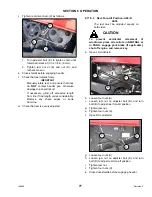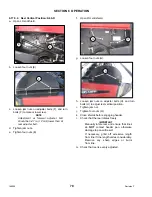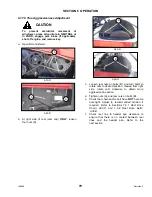
SECTION 6 OPERATION
169000
88
Revision F
6.17.14 Forming
Shields
WARNING
Keep hands and feet away from discharge
opening. Keep everyone several hundred
feet away from your operation. Never direct
the discharge toward anyone. Stones or
other foreign objects can be ejected
with force.
Position of forming shields controls the width
and placement of the windrow. The decision on
forming shield position (settings between 36 in.
and 92 in. [915 and 2346 mm]) should be made
based on the following factors:
•
weather conditions (rain, sun, humidity,
and wind),
•
type and yield of crop,
•
drying time available, and
•
method of processing (green-feed,
bales, silage).
A wider windrow will generally dry faster and
more evenly, resulting in less protein loss. Fast
drying is especially important in areas where the
weather allows only a few days to cut and bale.
Refer to Section 6.18 HAYING TIPS for
more information.
Where weather conditions permit, or when
drying is not critical, for example, when cutting
for silage or green-feed, a narrower windrow
may be preferred for ease of pick-up.
6.17.14.1 Side Deflectors
The position of the side forming shields controls
the width and placement of the windrow.
CAUTION
To prevent accidental movement of
windrower, place all controls in NEUTRAL or
in PARK, engage park brake (if applicable),
shut off engine, and remove key.
To ensure windrow placement is centered with
respect to carrier/drive wheels, adjust both side
deflectors to the same hole position on the
adjuster bar.
To achieve this setting, adjuster bars must be in
the corresponding hole both sides.
a. Set forming shield side deflectors to desired
width by repositioning adjuster bars as follows:
1.
For self-propelled machines,
remove
lynch pin (A), move adjuster bar (B) to
another hole, and reinstall lynch pin (A).
2.
For pull-type machines,
remove hairpin
and clevis pin (C). Move adjuster bar (D) to
another hole, and reinstall clevis pin (C)
and hairpin.
b. If forming shield attachment is too tight or too
loose, adjust as follows:
1.
On self-propelled headers,
tighten or
loosen nut (E) as required.
2.
On pull-type headers,
back off top nut
at (F), and adjust lower nut at (F) as
required. Then, holding lower nut with a
wrench, tighten top nut securely against
lower nut.
SELF-PROPELLED
B
A
PULL-TYPE
C
D
PULL-TYPE
SELF-PROPELLED
F
E
Summary of Contents for A30-D
Page 2: ...MACDON A40 D SELF PROPELLED AUGER HEADER MACDON A30 D PULL TYPE MOWER CONDITIONER...
Page 3: ...169000 1 Revision F...
Page 4: ...169000 2 Revision F...
Page 6: ...169000 4 Revision F...
Page 181: ...NOTES 169000 179 Revision F...
Page 182: ......
















































